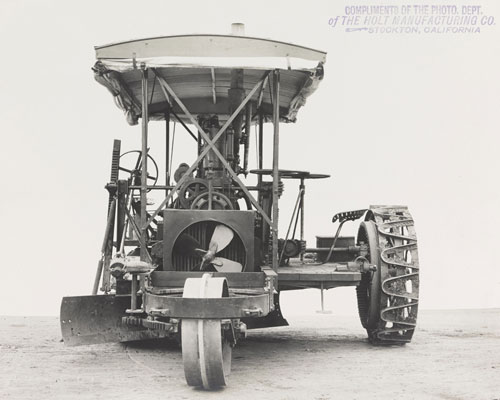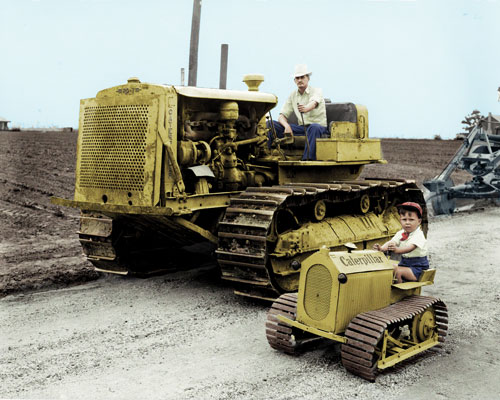Amidst the Great Depression, 1931 became a landmark year for Caterpillar innovation.
In 1931 the world was in the middle of the Great Depression, the deepest and longest-lasting economic downturn in the history of the industrialized world. Consumer spending and investments dropped, causing steep declines in industrial output and rising levels of unemployment as failing companies laid off workers. Caterpillar was also feeling the effects, as sales were down over $7 million from the year before, but this did not halt the company’s commitment to innovation. As it turns out, 1931 became a landmark year for Caterpillar innovation, and many of these developments are still relevant to our business today. You could say that these tough times set in motion many of the innovations we see in the 21st century.
The Diesel Engine
"Old Betsy" was the nickname given to the hand-built prototype of Caterpillar's first diesel engine model, the D9900. Research and development started as far back as 1927. What inspired Caterpillar leaders, such as Chairman C.L. Best, to keep investing in diesel technology during the Great Depression—a time when many other tractor companies were consolidating—was the recognition that the engine was superior to its gas counterpart. Diesels generated massive low-end torque while consuming roughly half the fuel of a gas engine. Under the direction of Caterpillar engineer C.G.A. Rosen, the engine was assembled on June 28, 1930 in San Leandro, California. Old Betsy was used in tests for more than 16 months before it was deemed ready for production in late 1931.
Cat power units today still carry the DNA of this engine, but their first use was powering Caterpillar tractors. In October 1931, the company began producing its first diesel tractor model: the Diesel Sixty tractor. The company realized it was only a matter of time before the diesel track-type tractor would catch on. In June of 1932, the first Caterpillar Diesel for use by another manufacturer was sold to Thew Shovel Co. of Lorain, Ohio. This D9900 powered a 1.5-cubic-yard shovel. Other original equipment manufacturers (OEMs) soon saw the diesel's advantages and adapted it to their applications. The rest, as they say, is history. By the mid-1930s, Caterpillar was the largest producer of diesel engines in the world, making diesel technology the backbone of its business.
When the research department was moved from San Leandro to East Peoria in 1938, Old Betsy found her way to the East Peoria plant. Charlie Schad, a member of the original team that had built the engine, crated her up and put her in storage. In the mid-1960s some of the buildings at Caterpillar’s new research facility, the Technical Center in Mossville, were finished. Schad pulled Old Betsy from storage, gave her a fresh coat of paint, put her on a wooden base, and had her placed on display in the lobby of the new building.
A few years later, as Schad was getting ready to retire, some of the first state and federal emissions standards were going into effect. To test how Caterpillar’s engines fared against these regulations, several of them underwent smoke and emissions tests. To honor Schad, engineers also decided to test Old Betsy. C. G. A. Rosen, the person responsible for designing Old Betsy, traveled from California to witness the occasion. Forty-two years after she was first built, Old Betsy was put into a test cell, and to the amazement of the engineers, she passed the emissions and smoke tests with flying colors.
Forty years ago, Old Betsy was given to the Smithsonian’s Museum of American History in a formal ceremony on November 29, 1973, as it was deemed of “significant historical importance.” Caterpillar executives Bill Blackie, Louis Neumiller and Harmon Eberhard, along with Charlie Schad, were all present as honored guests.
Today, Old Betsy has found her way back home. The Smithsonian loaned the engine to the Peoria Riverfront Museum, next door to the Caterpillar Visitors Center. Museum visitors have the opportunity to see her in person, and they can learn more about the development of the first Caterpillar diesel engine and first diesel tractor at the Caterpillar Visitors Center.
The Motor Grader
By 1931 the idea of the motor grader had been around for some time. In 1909, the Holt Manufacturing Company, one of Caterpillar’s predecessors, created a crude grader called the “Good Roads Machine,” which was simply a track-type tractor with a blade fastened in the middle. The machine never caught on, and only a few were ever produced.
Caterpillar’s work on this iconic product dates back to 1928, when the company acquired the Russell Grader Manufacturing Company and created a new road machinery division to address motor grader development. Russell blade graders were frequently paired with Caterpillar tractors, so the companies explored opportunities to partner and expand their product lines. In April of 1931, Caterpillar introduced the Auto Patrol, which was different from similar products in that it was designed as one machine instead of a separate tractor with a grader frame fitted around it. The Auto Patrol quickly became recognized as the industry's first true motor grader. In fact, it was eventually renamed the Motor Grader and is still the industry standard today.
 Color Change
Color Change
Until December 7, 1931, Caterpillar equipment was gray with red trim, but in the 1930s Caterpillar decided to make a change. The goal was to find a color that would be visible at the greatest distance both day and night, yet still be pleasing to the eye. Tests narrowed down options to three colors: a shady yellow, a flash red and white. When the tests were over, “Hi-Way Yellow” was chosen. Later in the 1970s, paint specialists devised a deeper, distinctive yellow for exclusive identification of Cat machines, a color known today as “Caterpillar Yellow.”
Logo Change
In 1931 the company introduced its second trademark design. The Caterpillar trademark hadn’t evolved since the brand’s establishment in 1925; in fact, the first trademark was originally used by the Holt Manufacturing Company. Affectionately called the “Wavy Logo,” it consisted of the company’s name written in a wavelike script that resembled a crawling larva. The second trademark, which was red, had a more contemporary design. Although it was tweaked over time, this design remained relatively the same until 1957.
The Future of Innovation
Eighty-six years have passed since 1931—a year when Caterpillar made significant technological progress, established its commitment to innovation, and ensured the life and longevity of the company. As Caterpillar takes on new challenges over the next 100 years, the company will continue to invest in technology to meet the world’s future needs. Autonomous solutions, drone technology, virtual product development simulation, telematics technology and 3-D printing are just a few cutting edge technologies Caterpillar is using to meet that challenge. iBi


